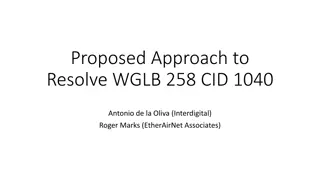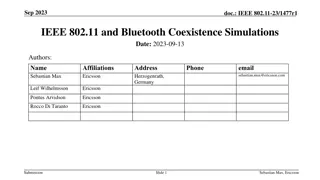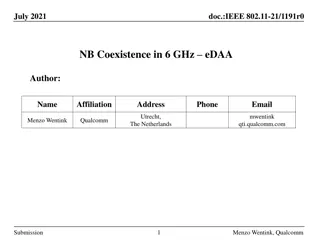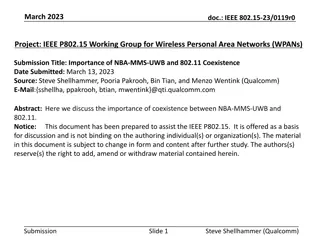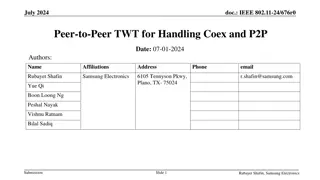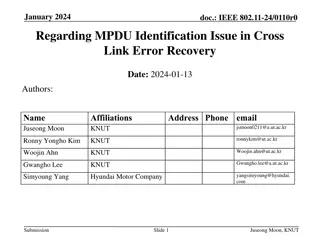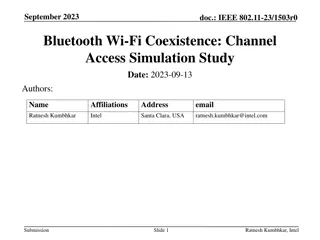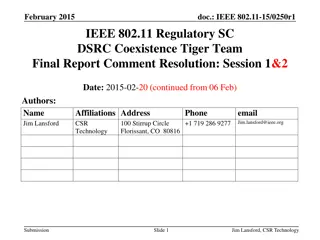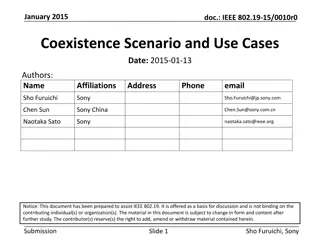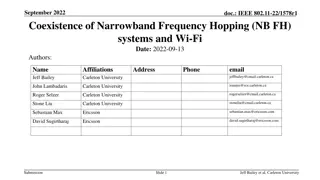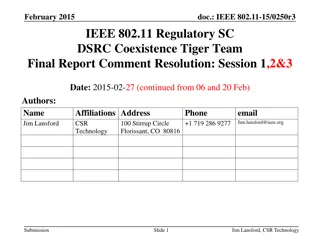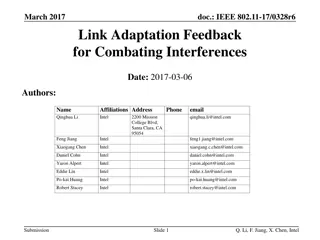IEEE 802.11-24/0002r0 A-MPDU Coexistence Feedback
This submission addresses coexistence issues during A-MPDU reception in IEEE 802.11-24/0002r0. It proposes a mechanism to mitigate problems that may arise, such as failures in MPDU reception leading to rate reductions and potential data flow interruption. The solution involves extending BlockAck frames to provide information for distinguishing between coex and channel issues.
Download Presentation

Please find below an Image/Link to download the presentation.
The content on the website is provided AS IS for your information and personal use only. It may not be sold, licensed, or shared on other websites without obtaining consent from the author.If you encounter any issues during the download, it is possible that the publisher has removed the file from their server.
You are allowed to download the files provided on this website for personal or commercial use, subject to the condition that they are used lawfully. All files are the property of their respective owners.
The content on the website is provided AS IS for your information and personal use only. It may not be sold, licensed, or shared on other websites without obtaining consent from the author.
E N D
Presentation Transcript
2 (a) PL/R ( b) the first node sends the P-th packet to the second node, thereby incurring a net delay of PL/R, the second node sends the (P-1)-th packet to the third node (c) for N links, there would be (N-1) intermediate nodes
3 (a) delay of L1 + delay of L2 + delay of Lp (b) he additional delay incurred would be max{Li}/R (c) for N links, there would be (N-1) intermediate nodes
4 (a) A B: 4 B C:4 C A:4 B A:4 (b) A C:4 C A:4 (c) A C B D 4
5 Time of transmission file + Time of circuit establishment
6 (a)(b) = / ( c )End to end delay = Propagation delay +Transmition delay. (d) trans (e) D prop > D trans => first bit ( ) (f) D prop < D trans => first bit ( ) (g) Dprop = D trans
7 time that data transforming to packet + the time of transmition + the time of propagation .
8 (a)circuit switching used up all resources equally devided to all users. (b)according to the course slide , each user are idled in 90% of time. (c)(d)
9 (a) the rate of link N / the number of users (b)you can use binomial distribution to represent it.
10 D end-end = L/R1 + L/R2 + L/R3 + d1/s1 + d2/s2 + d3/s3+ dproc+ dproc
11 D end-end = L/R + d1/s1 + d2/s2+ d3/s3
12 (a-1) one other packet is halfway done being transmitted on this outbound link 0.5 (a-2) four other packets are waiting to be transmitted 4 (a-1) + (a-2) = 4.5 (b) answer of (a) / 2Mbps (c) packets are already in the queue + bits of the currently-being-transmitted packet have been transmit ( n,L,x,R )
13 (a) delay: first transmitted packet : 0 second transmitted packet : L/R .. n-th transmitted packet : (n-1)L/R (b) (a)
14 (a) the queuing delay + the transmission delay (b) x = L/R x
15 14(a) answer a
16 N = a * d, where d = queuing delay + transmission delay.
17 (a) processing delay at the q th node the transmission rate of the q th link the propagation delay across the q th link (b) average queuing delay at node
21 (a) throughput (b) sigma
22 (a) (1-p) * (1-p) * .. ? (b) The number of transmissions needed to be performed until the packet is successfully received by the client is a geometric random variable with success probability Ps the average number of transmissions needed is given by: 1/Ps
23 (a) If the bottleneck link is the first link, then packet B is queued at the first link waiting for the transmission of packet A (b) L/Rs + L/Rs + dprop < L/Rs + dprop + L/Rc L/Rs + L/Rs + dprop + T >= L/Rs + dprop + L/Rc
24 = / link
25 (a) R * D prop (b) (a) (c) R * D prop (d) the width of a bit = length of link / bandwidth-delay product (e)express the width of a bit s R m
26 s/R=20000km R= ?
27 (a) R * D prop (b) size of file < bandwidth-delay product (c) the width of a bit = length of link / bandwidth-delay product
29 geostationary satellite is 36,000 kilometers away from earth surface.
31 (a)Time to send message from source host to first packet switch * hops (b) Time to send 1st packet from source host to first packet switch*2 (c) Time at which 1st packet is received at the destination host = (b) * 3 hops After this, every 5msec one packet will be received (d) message segmentation (e) message segmentation
33 F/S packets Each packet is S=80 bits Time at which the last packet is received at the first router is


